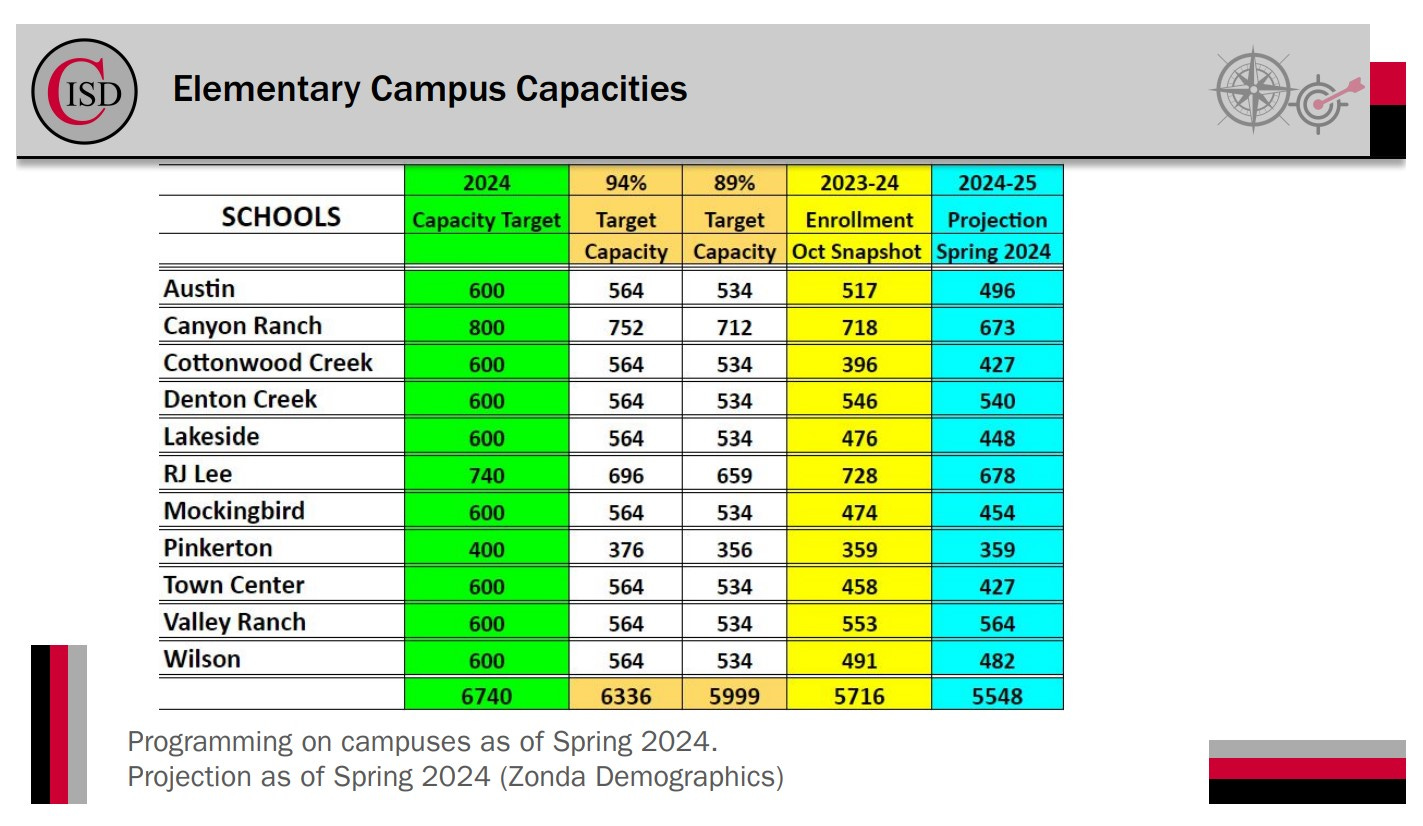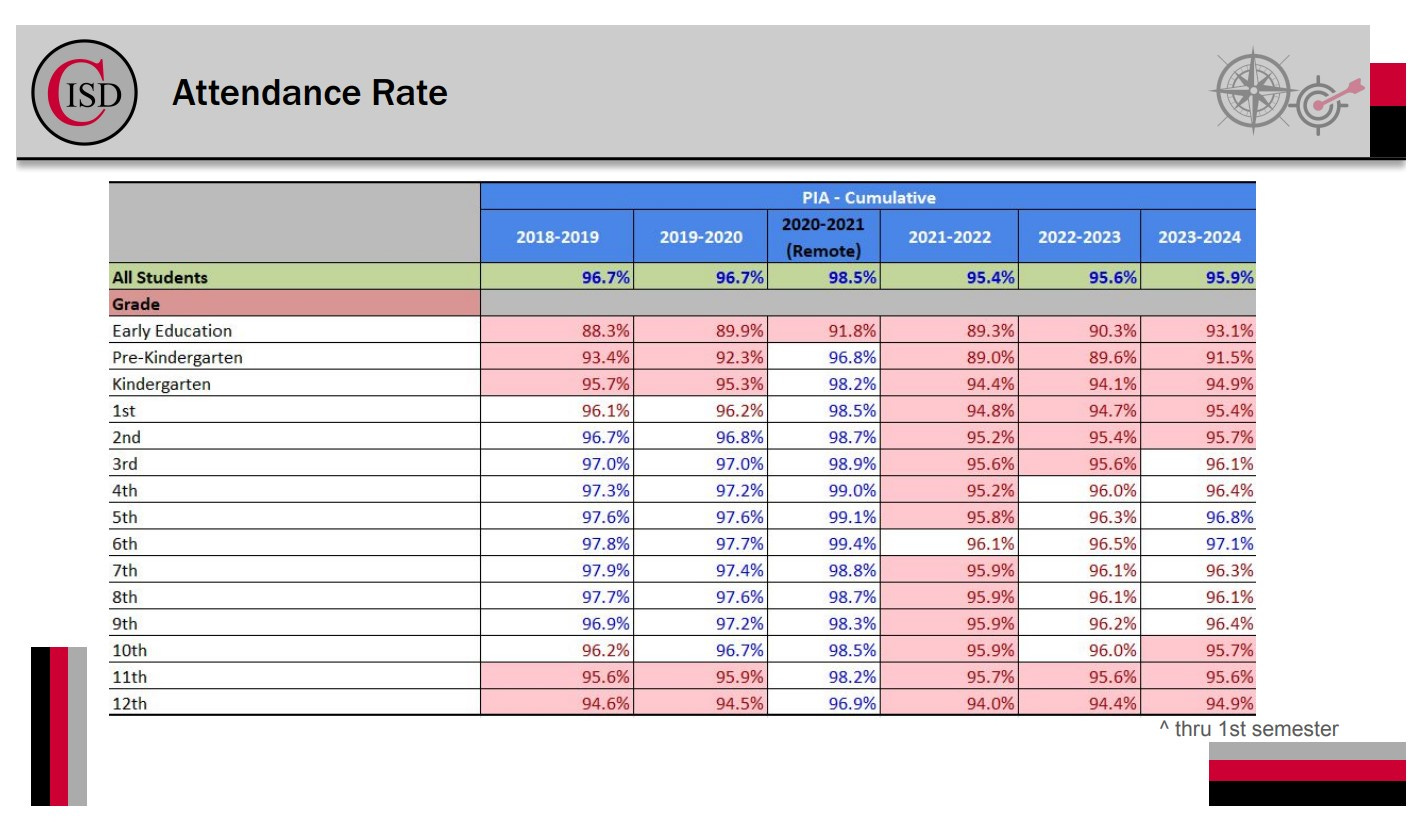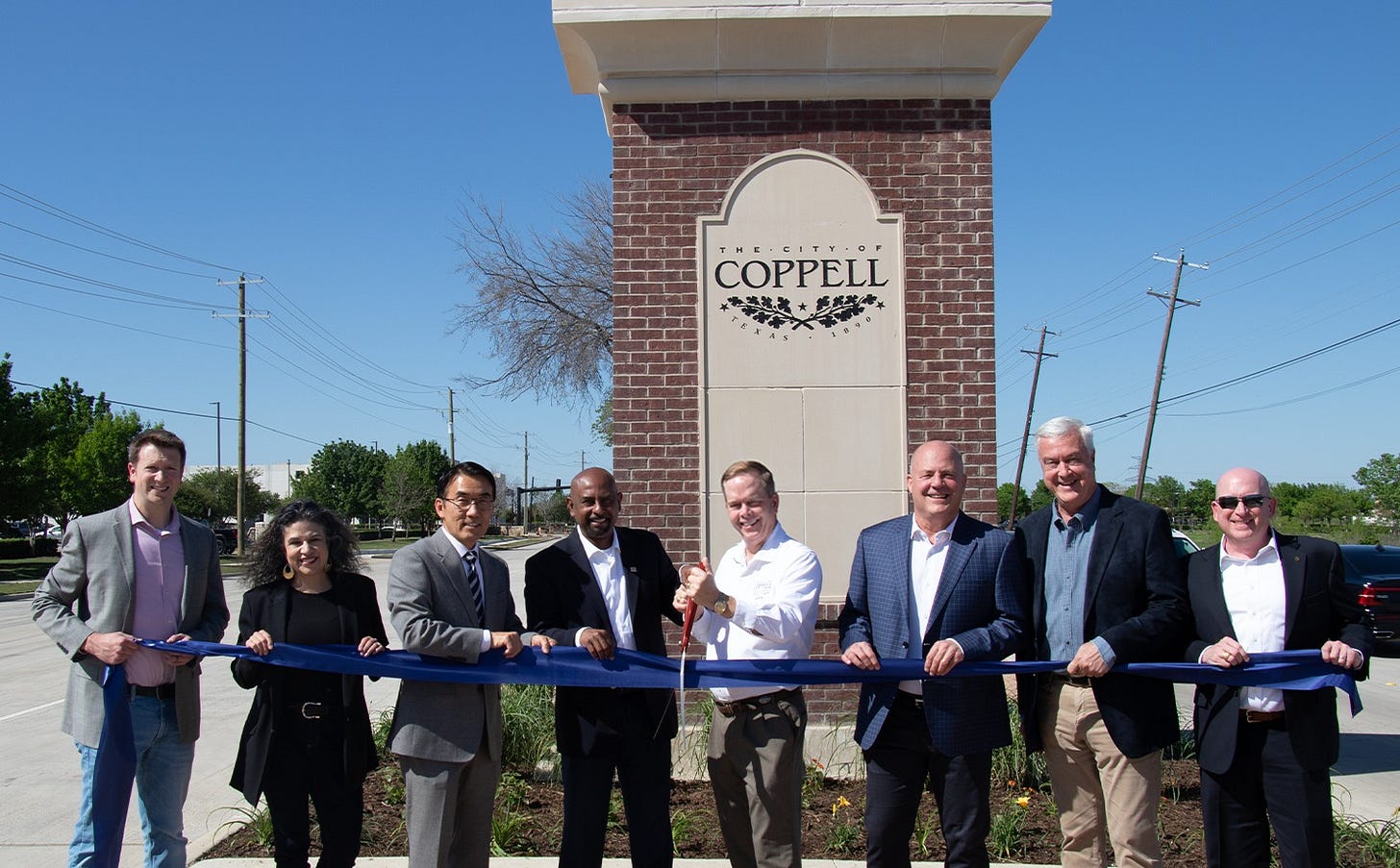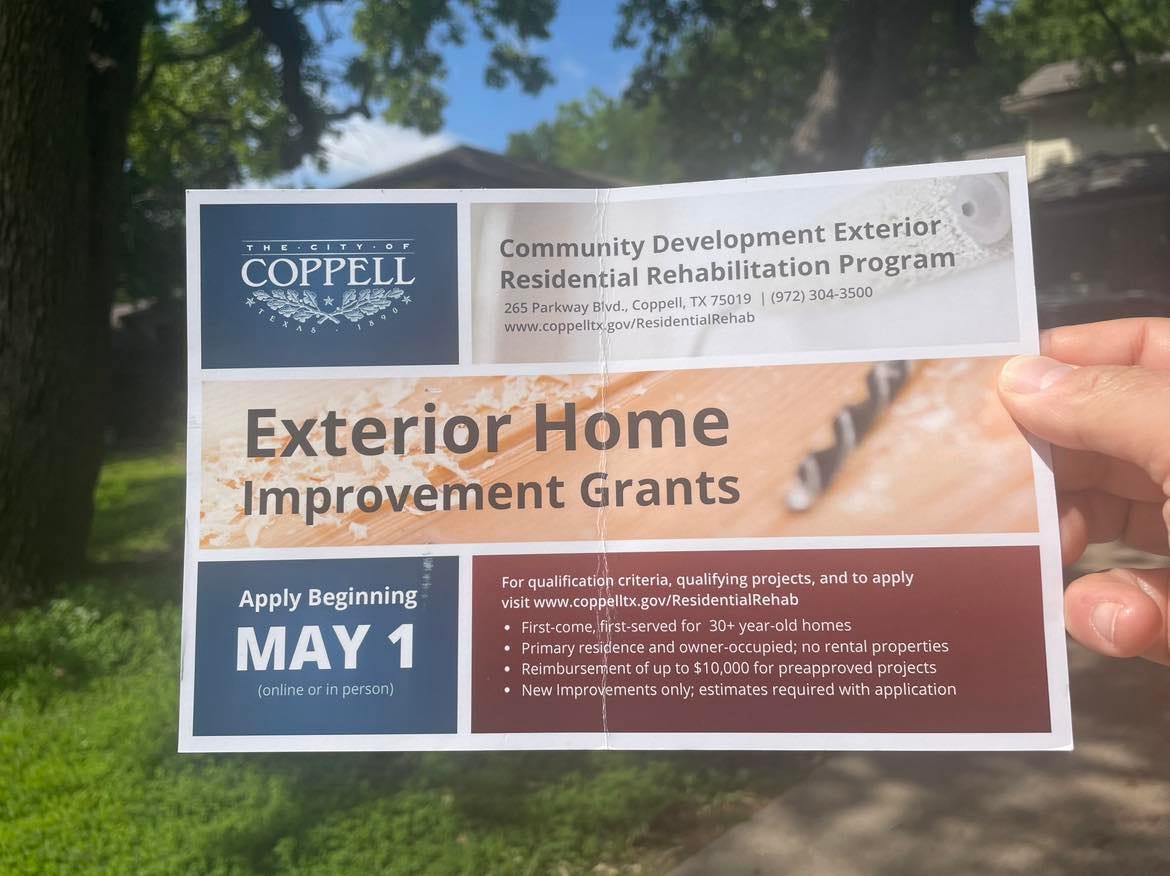Coppell Chronicle Vol. 4, No. 8
Could Coppell ISD Close Two Campuses? • Attendance Affects District’s Bottom Line • Trustees Approve Raise for Superintendent • Council Rejects Senior Living Proposal
Near the end of Thursday’s meeting of the Coppell Library Advisory Board, Frank Gasparro and Martha Garber discussed an upcoming event called “Local Journalism with Dan Koller.”
Gasparro: “I’m glad to see you guys have him coming in. He’s a really good guy and knows his stuff.”
Garber: “I think he’ll be entertaining.”
Gasparro: “Yeah, he’s a funny guy, too.”
Garber: “He is funny.”
Well, the pressure’s on now. If you have no other plans between 2 and 3 on Saturday afternoon, stop by the Cozby Library and Community Commons to find out whether I live up to the hype.
Could Coppell ISD Close Two Campuses?
I’ve wrapped my brain around the idea of Coppell ISD closing a campus, and I’ve urged my readers to do the same. But Trustee Manish Sethi blew my mind last week when he suggested the district could shutter two elementary schools.
Sethi floated that idea on Monday evening during a workshop dedicated to solving CISD’s budget woes. After the trustees spent more than two and a half hours debating demographic projections, an expansion of open enrollment, and potentially putting a tax increase on the November ballot, Sethi said closing a school would be “something close to a silver bullet.”
Board President David Caviness agreed with Sethi: “We’ve spent three hours talking about table scraps when this is really the silver bullet to make a dent in the problem we have.”
Here’s that problem, in a nutshell: The amount of funding the district gets from the state has been stagnant while costs keep climbing. At the beginning of this school year, the trustees approved a budget with a projected deficit of nearly $13.6 million. A year earlier, they approved a budget that projected a $9.7 million deficit, but Chief Financial Officer Diana Sircar has said the actual deficit for 2022-2023 would probably be about $3 million. No matter the size of the deficit, the district is covering shortfalls by dipping into its fund balance, which is not a sustainable solution.
On Monday, Trustee Leigh Walker asked how much the district could save annually by closing one elementary school. After some discussion, Sircar agreed with Sethi’s estimate that the savings would add up to between $2 million and $2.5 million. Although some teachers would follow students to their new schools, you’d be eliminating the salaries of a principal, an assistant principal, a counselor, a nurse, a librarian, a P.E. teacher, an art teacher, etc.

The districts’ elementaries are projected to have a combined enrollment of fewer than 5,550 next school year, and that number is expected to keep dropping. Meanwhile, Sethi pointed out, the bond-funded renovations of three campuses will increase the elementaries’ combined capacity from 6,740 to 7,000. Because each of the nearly identical “footprint” elementaries can hold up to 600 kids as is, he suggested the district could afford to close two schools.
“We still won’t be even close to the capacity in our elementary schools if there were two less facilities,” Sethi said. “We’d still have plenty of excess capacity.”
Although his logic is sound, I doubt I was the only person surprised by Sethi’s suggestion. The trustees and administrators were oddly silent for several seconds after he made it.
“Dollar and cents wise, closing a campus makes sense,” said Trustee Nichole Bentley, who then turned the discussion to what would happen next. She wondered whether a school could be converted into a new headquarters for the district, consolidating administrators who are spread across multiple facilities today. She threw out that possibility as a way to prevent a charter school operator from pouncing on an opportunity.
I did not know until I watched Monday’s workshop that Texas law says charter schools get first dibs on facilities shuttered by public school districts. Section 11.1542 of the Texas Education Code is called “Open-Enrollment Charter School Offer for District Facility,” and it says this:
a) The board of trustees of an independent school district that intends to sell, lease, or allow use for a purpose other than a district purpose of an unused or underused district facility must give each open-enrollment charter school located wholly or partly within the boundaries of the district the opportunity to make an offer to purchase, lease, or use the facility, as applicable, in response to any terms established by the board of trustees, before offering the facility for sale or lease or to any other specific entity.
b) This section does not require the board of trustees of a school district to accept an offer made by an open-enrollment charter school.
This law’s existence was also news to Trustee Jobby Mathew, who said he was “absolutely flabbergasted.” Demonstrating that charter schools are perceived as competitors, he then came up with one heck of a sports analogy: “It’s like you’re playing a basketball game, you spotted them 20 points, you’re blindfolded, and you’ve got to play on one leg, just to be able to compete.”
Monday’s discussion was just that — a discussion. And more discussions will happen before any decisions are made. If you want to be involved, you have an opportunity to volunteer for a Strategic Planning Implementation Team. And if you just want to learn more about the budget situation, consider attending an update scheduled for 6 p.m. on Wednesday in the Coppell High School lecture hall or tuning into a Facebook Live session that the district will broadcast on May 1.
Those sessions will probably feature a lot of the same information that the district presented on April 4 during a Budget Community Dialogue event at Coppell High School. I was there briefly, and it looked like there were fewer than a dozen people in the cafeteria who weren’t CISD employees or trustees.
“These are serious topics, and it’s about to get even more real,” Superintendent Brad Hunt said Monday, “so we would love to have more involvement.”
Attendance Affects District’s Bottom Line
If you want to help Coppell ISD’s bottom line, send your kids to school more often.
Texas’ funding of public school districts is dictated by their average daily attendance. During Monday’s budget workshop, Chief Financial Officer Diana Sircar showed this slide displaying each grade level’s attendance rate for the fall 2023 semester and the five previous school years. The red rates are below the district’s pre-COVID average of 96.7 percent. The red rates with red backgrounds are at least a full percentage point below that mark.
Last school year, the district’s overall attendance rate was 95.6 percent. Last semester, it crept up to 95.9 percent.
“Our fifth- and sixth-graders look like they’re the ones that are carrying the district right now,” Sircar said, because those were the only two grade levels above 96.7 percent last semester.
Superintendent Brad Hunt added: “And we appreciate them. More importantly, we appreciate their parents because they’re helping to get them there.”
Sircar said each percentage point in the district’s average attendance rate equates to $1 million worth of funding from the state.
“This is like an ‘easy’ million dollars,” Trustee Nichole Bentley said, placing finger quotes around the word “easy.”
Chief Communications Officer Angela Brown said the district began the school year with a multi-pronged “Attendance Matters” marketing campaign that will be revived as the spring semester winds down and will also be deployed this fall. That $1 million statistic is a key piece of the presentation.
“You hear some gasps in the audience every time we say it,” Brown said.
Trustee Ranna Raval said it’s great to inform parents of that stat, but “I was just wondering if the kids know, especially the money part, middle schoolers and high schoolers, because it gets their attention.” Raval said she explained the financial implications of absences to her teenage daughter, and they now try to schedule any weekday appointments for the girl after 12 p.m., because attendance is taken in the morning.
That jibes with what a civically minded subscriber told me she did last Monday, when she took her freshman to the city’s Total Eclipse of the Park party. Knowing how important attendance rates are to the district’s budget, this mom waited until after roll call to pick up her daughter from CHS9.
Trustees Approve Raise for Superintendent
Right before adjourning their March 26 meeting, the Coppell ISD trustees unanimously approved “the superintendent’s contract as presented.”
The next morning, I emailed Director of Communications Amanda Simpson to ask how it was presented. She said the new contract would be posted on Coppell ISD’s website for all to see after Superintendent Brad Hunt signed it.
Due to a conference in Austin and various other commitments, Hunt didn’t autograph his new contract until Monday. It says his new base salary is $281,324.16. (Don’t forget those 16 cents!)
In June of 2022, Hunt and Board President David Caviness signed a contract that set his base salary at $260,100. One year ago, they signed an addendum that raised it to $270,504. That raise and the one enacted this year represent 4 percent increases, which is what the trustees have approved for the rest of the district’s employees. Hunt’s new contract also calls for a one-time bonus of $2,825 and annual payments of $1,500 because he earned a doctoral degree.
Coppell ISD trustees have a list of priorities that guide their budget discussions, and the first item on that list is “Remain a leader in Salary/Benefits; Employee Retention.” Caviness told me that extends all the way to the district’s top employee. In the last few years, there’s been a rash of superintendent resignations and retirements across North Texas. Caviness said the trustees don’t want Hunt — who is Dallas County’s longest-tenured superintendent — to be lured away by another district.
A quick survey of the districts bordering Coppell ISD shows that all four of them pay their superintendents more than what Hunt is being paid. However, all of those districts have larger student bodies than Coppell ISD. Brad Schnautz, who got the top job in Grapevine-Colleyville ISD last year, is the only one who earns more than Hunt on a per capita basis.
Hunt was named superintendent in 2017, but he’s worked in Coppell ISD for virtually his entire career, except for a brief stint in the House of the Dragons a couple of districts to our west. He got his first teaching gig at Coppell High School in 1990, when one of his bosses, Trustee Leigh Walker, was beginning her senior year.
The termination date in Hunt’s new contract remains the same: Dec. 31, 2027. Seven months prior to that is when his youngest child and my youngest child should (fingers crossed!) receive their high school diplomas.
Council Rejects Senior Living Proposal
Two weeks ago, I published an article called “Senior Housing Project Aims to Avoid Taxes.” It was about a proposal by a Minnesota company called Roers Companies to build a four-story building featuring 232 apartments on the corner of North Coppell Road and Canyon Drive.
Roers representative Logan Schmidt told the Coppell Planning and Zoning Commission that his firm and its investors would receive tax credits from the federal government by reserving the apartments for people who make 60 percent or less of the area’s median income. Additionally, he said Roers planned to partner with a nonprofit called the Texas Housing Foundation so the project could qualify for a state exemption from local property taxes.
After the Planning and Zoning Commission meeting, Roers reduced the number of apartments in its plans from 232 to 217. But those plans are out the window now, because the City Council rejected the requested zoning change by a vote of 6-0 on Tuesday. (Council Member Biju Mathew was absent.)
“The citizens of Coppell have made it quite clear about their lack of appetite for high-density housing, especially a 40 million dollar project not paying any property taxes,” Council Member Mark Hill said.
Leaving the tax issues aside, Council Member Jim Walker was opposed for zoning reasons: “I think the 21.9 units per acre is simply too dense, particularly as it lies immediately west of a neighborhood, a single-family residential neighborhood. I think the 50-foot maximum height is simply too tall. I mean, on a normal summer afternoon, I think the sunset would start at about 5 p.m. for that neighborhood.”
Here are a few other notable aspects of Tuesday’s meeting:
• By another 6-0 vote, the council approved the zoning changes necessary for the construction of Fire Station 5 on Moore Road. Although some residents expressed opposition when the matter came before the Planning and Zoning Commission last month, as documented in “Plans for Fire Station Keep Trucking Along,” nobody signed up to speak during Tuesday’s public hearing.
• The council’s consent agenda included a $67,600 contract with Samit Patel so he can continue his work designing a veterans memorial. His previous employer, Olsson Studio, eliminated its local landscape architecture division, according to a memo from Director of Community Experiences Jessica Carpenter. After meeting with a new Olsson contact based in another state, Carpenter wrote, her staff was not confident that the memorial project would receive “the same level of attention to detail, local support, and engagement.”
• In last week’s article called “All Lanes are Open on South Belt Line Road,” I said I was eager to see how the city could conduct a ribbon-cutting ceremony without closing at least one lane. During Tuesday’s meeting, Deputy City Manager Kent Collins revealed that such a ceremony happened on April 4, before the lanes were opened, and it was “safe for all involved.” Here’s photographic evidence of the entire City Council being involved safely.
One other thing about Tuesday’s council meeting: It lasted about two hours and 15 minutes, and more than a quarter of that time was devoted to pickleball (discussing it, not playing it). Meet me back here next Sunday to read about how that discussion went.
Restaurant Roundup
• If, like me, you’ve been wondering what’s going on at the former home of Ms. Mary’s Southern Kitchen — which was previously the home of the Deliman’s Grill — wonder no more. A Texas Alcoholic Beverage Commission notice taped to the window says that building on Denton Tap Road will soon be occupied by the Double Yoke Cafe. Matthew Zimmerman, a leasing agent for The Retail Connection, told me it will be a “brunch spot.” (Those two words were the entirety of his response to my emailed inquiry.)
• The leasing flyer for Point West, the shopping center on the northwest corner of Belt Line Road and Interstate 635, has been updated to indicate that Dunkin’ will soon have a new next-door neighbor called Grain & Berry.
• Lynne Pence, who was quoted in last week’s article called “Old Town Parking Signs Spark Complaints,” had more to say in the comments on my website: “Here’s a scoop for you that anyone from Ohio will be thrilled to hear. Ralph and I are opening a Donatos Pizza franchise in Flower Mound (1400 Long Prairie Rd) in September. We are going to do 3 locations and are looking for a place in Coppell for our second location.”
Chronicle Crumbs
• In an attempt to boost enrollment, Coppell ISD will host a pair of popsicle parties this week for prospective kindergartners and their families. The first one is scheduled from 5:30 to 6:30 p.m. on Tuesday at the Kid Country playground outside The CORE in Coppell. The second one will happen between 5:30 and 6:30 p.m. on Wednesday at North Lake Ranch Park in Irving.
• Beth Van Duyne, who represents most of Coppell in Congress, bought an ad in the New York Post last week that urges police officers from the Big Apple to apply for jobs in Texas. The ad listed email addresses for 15 law enforcement agencies in the Dallas-Fort Worth area, including the Coppell Police Department. Officer Kelly Luther told me Van Duyne and her campaign staff did not inquire about Coppell’s staffing needs before placing the ad, but they did give the police department a heads-up that it would be published.
• A few subscribers have asked me, in so many words, “What’s the deal with Interstate 35E?” Each side of the highway is being expanded from three lanes to four, and a third lane is being added to each frontage road. The work is happening between Interstate 635 and the Denton County border, and it’s expected to last until 2025. I know all that because I discovered the project has a webpage, a second webpage, and its own Facebook page.
• If you still have your eclipse sunglasses, drop them in a bucket on the porch at 324 Willow Springs Drive in Coppell. Senior Girl Scout Troop 6445 will donate them to Astronomers Without Borders so they can be distributed to people in other countries that will be in the paths of future eclipses.
• Last December, I published an article called “Code Violators Given 90-Day Deadlines” that stemmed from a rare meeting of Coppell’s Building and Standards Commission. That commission reconvened on Thursday to discuss the same two properties they talked about in December. I wasn’t able to be there, but Chair Mark LeGros told me both were found to be in compliance.
• Back in February, I published an article called “Coppell to Help Homeowners With Grants.” On Saturday, I pulled this related flyer out of my mailbox.
Community Calendar
City Council & CISD Candidates Forum: Candidates for the Coppell City Council and the Coppell ISD Board of Trustees have been invited to a forum that the Coppell Chamber of Commerce will host between 5 and 7 p.m. on Tuesday at Dallas College’s Coppell Center.
Assistance League of Coppell meeting: A representative from the Coppell Arts Center will speak at the league’s monthly meeting on Thursday at Valley Ranch Baptist Church. A social gathering will start at 11 a.m., followed by the meeting at 11:30. Members and guests typically go to lunch after the meeting.
Family Reading Night: The Assistance League of Coppell has been presenting this weekly series between 6 and 7 p.m. on Thursdays at the Coppell YMCA. In this week’s final edition, Tim Brubaker will read from Pedro’s Magic Christmas and Vincent Walker will present It’s a Garden Out There, which is illustrated by Madalyn Jones. The program is free, but books are available for purchase and autographs.
Vivace Spring Show: Coppell High School’s show choir will perform at 7 p.m. on Friday and Saturday in the school’s auditorium, where they will be joined by show choirs from Coppell Middle School East and Coppell Middle School West.
Cowboy Theatre Company Spring Showcase: Actors from Coppell High School and New Tech High will take the stage in the CHS Black Box at 7 p.m. on Friday and Saturday and 2:30 p.m. on April 21.
Charlotte’s Web: Theatre Coppell will stage three more performances of a play based on E.B. White’s beloved book. The next show is scheduled for 8 p.m. on Friday at the Coppell Arts Center.
Earthfest: Environmental, sustainable, and nature-themed projects and initiatives within the community will be highlighted between 11 a.m. and 1 p.m. on Saturday at the Biodiversity Education Center.
Erth’s Dinosaur Zoo Live: A team of puppeteers will bring a collection of lifelike dinosaurs and other creatures to the Coppell Arts Center for two performances at 2 and 6 p.m. on Saturday.
Aggie Muster: Former students of Texas A&M University will meet at the Coppell Senior and Community Center at 6 p.m. on April 21 to honor Aggies who passed away within the last year. The event will include a happy hour, a barbecue dinner, and remarks by Mark Klemm ’81.
Coppell Lariettes Spring Show: The Coppell High School drill team will perform at 7 p.m. on May 3 and 4 in the school’s auditorium.
Run to Fund: The Coppell ISD Education Foundation’s 5K and 1-mile fun run will happen on May 4 at Andrew Brown Park East.










After I published this edition, a subscriber texted me to say she’d detected activity at the Biscuit Bar. This was certainly news to me, as I wasn’t aware the Biscuit Bar had been shut down. When a restaurant is never open for dinner, it’s hard for a commuter like me to notice that they’re never open period.
Excellent story on CISD. I am shocked about the state giving charter schools first dibs on closed schools. Public ed is under attack in Texas.